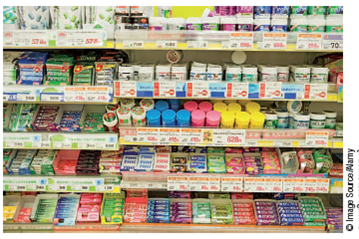Negotiating on Retail Slotting Fees. Retailers charge their suppliers slotting fees to secure a place on their shelves. If you're in the process of getting your first product into a major store, you'll need to be ready to negotiate these fees when you agree on pricing. In the world of promotion today, payments in the form of slotting fees, cash allowances, and incentives are becoming more popular due to the growing power of. Manufacturers c. Although implementing slotting fees can help a business offset risks and cover stocking costs, it can become an ethical issue if it A. Eliminates tax incentives. Encourages economic growth. Reduces competition. Supports competing agreements.
A buyer for a major retail chain finally closes the deal and buys your product. The big day has come for your product to shine on the shelf space it deserves. However, you are disappointed to realize you only have a small slot on the shelf and your product is overtaken by the big brands next to it. It is impossible for your product to compete with these brands. What is the process for successfully getting your product to the shelf, and how can you guarantee a good space?

Most consumers unknowingly fall victim to slotting fees controlling their purchasing decisions. Oh, look how convenient it is to grab that eye-level abundant product on the shelf! Why even bother looking at the possibly better product in a single slot on the bottom shelf? With this system in place, retail store offerings shift the control from customer desires to marketing budgets. This can create a barrier for new brands entering the market.
What are slotting fees?
Slotting fees are one-time payments a supplier makes to a retailer as a condition for the initial placement of the supplier's product on the store's shelves. This system allows the retailer to protect its return on investment when buying a new product. With 70–80 percent of new products failing, the cost to introduce a product on shelves can be more than the sales received in return. Slotting fees reduce the risk of loss for the retailer.
Where did they come from?
Introduced in the 1980s, slotting fees were initially only demanded by a few stores. Daniel Lubetzky, the founder and CEO of KIND, recalls slotting fees just becoming prevalent when he launched his brand in 1993. In the following years, a grocery store merger mania left many stores desperate and in debt. As a response, these stores looked for any way to make money, and charging slotting fees was an easy one. Lubetzky says, 'Slotting ended up becoming more common and more institutionalized.' Nielsen data shows that 85 percent of retailers were charging slotting fees by 2000. Now, almost twenty years later, they have become a standard in the retail industry and almost impossible to avoid.
For many stores, slotting fees are necessary to keep the revenue flowing. Walmart was late to introduce them, first charging certain brands in 2015. It is believed that Walmart's increase in wages that year was the catalyst for introducing the fees. The company needed to increase its revenues to balance its increase in wage expenses, and slotting fees were an easy fix.

Most consumers unknowingly fall victim to slotting fees controlling their purchasing decisions. Oh, look how convenient it is to grab that eye-level abundant product on the shelf! Why even bother looking at the possibly better product in a single slot on the bottom shelf? With this system in place, retail store offerings shift the control from customer desires to marketing budgets. This can create a barrier for new brands entering the market.
What are slotting fees?
Slotting fees are one-time payments a supplier makes to a retailer as a condition for the initial placement of the supplier's product on the store's shelves. This system allows the retailer to protect its return on investment when buying a new product. With 70–80 percent of new products failing, the cost to introduce a product on shelves can be more than the sales received in return. Slotting fees reduce the risk of loss for the retailer.
Where did they come from?
Introduced in the 1980s, slotting fees were initially only demanded by a few stores. Daniel Lubetzky, the founder and CEO of KIND, recalls slotting fees just becoming prevalent when he launched his brand in 1993. In the following years, a grocery store merger mania left many stores desperate and in debt. As a response, these stores looked for any way to make money, and charging slotting fees was an easy one. Lubetzky says, 'Slotting ended up becoming more common and more institutionalized.' Nielsen data shows that 85 percent of retailers were charging slotting fees by 2000. Now, almost twenty years later, they have become a standard in the retail industry and almost impossible to avoid.
For many stores, slotting fees are necessary to keep the revenue flowing. Walmart was late to introduce them, first charging certain brands in 2015. It is believed that Walmart's increase in wages that year was the catalyst for introducing the fees. The company needed to increase its revenues to balance its increase in wage expenses, and slotting fees were an easy fix.
How much are the fees?
Costs vary greatly and depend on the industry or section of the store. According to the trade publication Frozen and Refrigerated Foods, freezer section space in small chains costs up to $9,000. In larger chains, this number skyrockets. For example, Apple & Eve spent around $150,000 to get its fruit punch into a limited number of Safeway stores. These steep one-time costs are sometimes the only way to guarantee shelf space. According to UCONN's Food Marketing Policy Center, the total market for slotting fees is believed to total around $9 billion, and it continues to grow. Be ready for some steep requests.
What to know
Chains vary on whether their supplier business deals include slotting fees or not. It is important to research these policies and know what to expect before going into a deal. National stores such as Kroger, Safeway, and Walmart use them, as do regional stores such as QFC and Fred Meyer. It is difficult to find stores that do not take advantage of this potential profit, but Trader Joe's and The Fresh Market are a few.
A study by NAICS reveals the most common industries that are charged slotting fees by retailers or manufacturers. This does not include every retailer, but it can give you a good idea of what to expect for your product.
Common slotting fee industries
- Breakfast cereal
- Confectionary
- Frozen food
- Ice cream
- Bakeries
- Tortillas
- Snack food
- Seasoning and dressing
- Beverage
- Tobacco
Common non-slotting fee industries
- Flour
- Oils
- Sugar
- Dairy
- Meat
- Seafood
Slotting Fees Definition
How to negotiate slotting fees
It is difficult to avoid the fees entirely, but by presenting a good argument for how you can guarantee early sales, the retailer may take it easy on the expense demands.
- Present a plan. Know what shelf space you want and how much you want to spend on it, but stay reasonable. It is important to prevent the retailer from walking all over you and up-charging for the space.
- Use sales and marketing. Offer promotions, coupons, and demos to guarantee brand awareness and product sales. By showing that yours isn't going to be one of the 80 percent of products that fail, the retailer will feel less of a need to strongly protect its investment.
- Have the stats. Prove there is current demand for your product and that it will sell if placed right. You need to exceed the average presentation and provide solid evidence that consumers are actively looking for your exact product.
- Measure and renegotiate. Monitor your sales in each store and renegotiate if sales are going very well. Remember that when you win, so does the store. Look for frequent stockouts, for instance, to indicate unmet demand that could warrant another facing on the shelf.
A Slotting Fee Is A Form Of Flattery
From the looks of it, slotting fees are not going anywhere. They continue to be a battle for small companies while simultaneously protecting retailers from losses. It is important to recognize their place in the future of your product and work to jump the hurdle they create.
